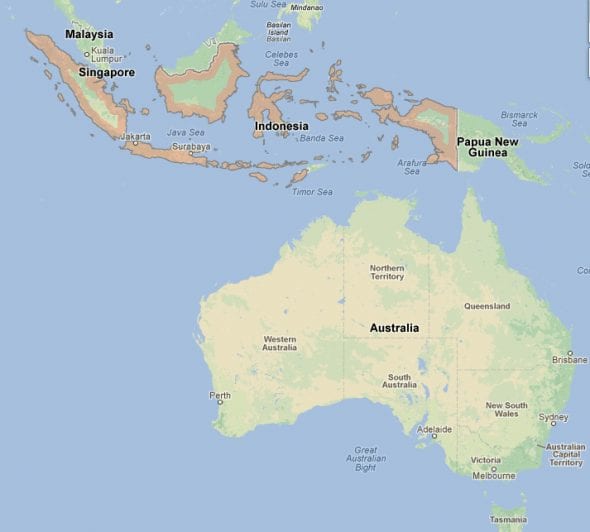A proposal to develop a 2000km sub-sea cable to supply Indonesia with renewable energy generated in Australia’s north-west has been described as financially viable and possible within the decade.
The West Australian reports that a private consultant has been hired by the Pilbara Development Commission to investigate the establishment of an underwater link to transport solar power from the Pilbara and Kimberley to Java in Indonesia.

The consultant, named by the paper as Geoff James, is due to deliver a pre-feasibility study to the commission in January as to whether it is possible to build the ambitious 2000km underwater power link.
“We have been assisted by project partners who have advised us that it is a ‘technical stretch’ but it is quite feasible,” James said. “The technology does exist and it has been trialled at various lengths, various scales, various depths across the globe. They are developing the technology very rapidly.”
Reportedly, the project would also require a substantial solar farm to be built in the Pilbara and Kimberley, as well as the high-voltage direct cable-transmission route stretching from the Pilbara through the Kimberley and on to Java.
James said the subsea part of the cable – 2000-odd km of it – was being developed in consultation with Basslink and a silent project partner.
Of course, the idea of exporting solar power from one nation to another is not new. Having switched on his country’s Noor 1 concentrating solar thermal plant in February, the King of Morocco hopes to transform all of the nearly useless chunk of the Sahara Desert into a solar energy export hub, targeting the European market.
As reported here, there’s already one interconnection between Europe and Morocco, through the Straits of Gibraltar, although currently 5 billion kWh’s a year are imported from Spain to help meet Morocco’s power shortfall. That should be reversed in time, and there are plans to build more transmission lines.
“If Morocco is able to generate electricity at seven, eight cents per kilowatt – very possible – it will have thousands of megawatts excess,” said Paddy Padmanathan, CEO of the Saudi-owned developer of Norr 1, ACWA Power.
“This country should be able to export into Europe and it will. And it will not need to do anything at all…just sit there because Europe will start to need it.”
Saudi Arabia itself also has plans to export solar to Europe in winter, when cooler temperatures reduce demand for air conditioning in the kingdom.
In 2013, Khalid Al Sulaiman, vice president for renewable energy at the King Abdullah City for Atomic and Renewable Energy (KACARE) told a conference in Paris that it would be viable for Saudi Arabia to export up to 10 gigawatts, the equivalent of 10 nuclear plants, via North Africa and Italy or Spain.
And here in Australia, proponents such as Renewable Hydrogen’s Andrew Want were last year talking up the prospect of developing massive solar arrays in the Australian outback at a scale of “multiple tens” of gigawatts, to to tap into the voracious demand for clean energy from the big north Asian economies.
“This is a great opportunity to create a solar industry which is not limited to the scale of our electricity network,” Want told RenewEconomy at the sidelines of the 6th World Hydrogen Technologies Congress in Sydney in late 2015.
“This plan is bolted on to the prospects of the biggest economic growth region in the world.”
As RenewEconomy had previously reported, this was part of a big push in Australia to tap into Japan’s emerging “hydrogen” economy, and use Australia’s rich solar and wind resources to provide clean fuels to Japan and other countries.
News of the proposed international interconnector coincides with the findings of an independent investigation into the outage of Basslink’s undersea cable linking Tasmania with the Australian mainland.
As we have reported, the interconnector failed in December 2015, and became one of the key factors that combined to tip Tasmania into a months-long electricity crisis.
The outage, which lasted the better part of six months, was the subject of an extensive independent investigation, conducted by UK-based Cable Consulting International (CCI), and which itself spanned more than six months, including forensic examinations and laboratory analysis in Italy and the UK.
Despite the length and depth of the investigation, Basslink CEO Malcolm Eccles said on Monday that the CCI investigation had concluded that it was not possible to determine the cause of the fault.
“It is not uncommon that the cause of the fault remains unknown based on other past incidences of submarine cable outages,” said Eccles in comments on Monday.
“We have provided the report in its entirety to Hydro Tasmania and the Tasmanian government and trust it will provide them with sufficient expert evidence to accept that the fault was a force majeure event.”
These findings aside, Geoff James believes an international cable could have major benefits.
“This could be our key pillar of our relationship with Indonesia, a symbol of mutual benefit, the ability to improve its clean energy and meet its very ambitious growth targets,” he said in comments to The West.
“The main challenges are the relationships and the business models to make this work.”










